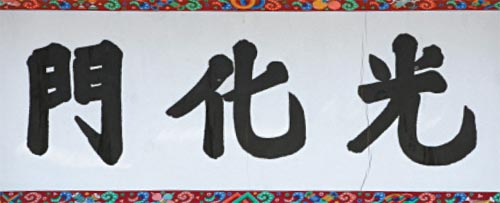After 11 weeks, cracks appear in palace gate

A vertical crack is seen on the left side of the Chinese character “Gwang” on the right side of the signboard of Gwanghwamun, the gate leading to Seoul’s historic Gyeongbok Palace. There’s another crack beneath the character “Hwa” in the middle of the board. [NEWSIS]
Minor cracks have appeared on the signboard of Gwanghwamun, the reconstructed main gate to Seoul’s Gyeongbok Palace, less than three months after it was unveiled to the public, starting a heated debate on shoddy government workmanship.
A long vertical crack can be seen on the left side of the Chinese character “Gwang” on the right side of the signboard. There’s also a crack beneath the character “Hwa” in the middle of the board.
“I’m curious why the signboard is cracked,” Kim Han-gil, a passerby, said. “It cracked not long after Gwanghwamun was restored.”
Democratic Party Representative Choi Moon-soon, a member of the National Assembly’s Culture, Sports, Tourism and Broadcasting Committee, on Wednesday blamed “shoddy workmanship.”
“Gwanghwamun’s new signboard was unveiled on the occasion of the celebration of the 66th anniversary of Korea’s liberation, and the cracks come as a shock because they’re visible to the naked eye,” Choi said in a press release.
The Cultural Heritage Administration of Korea released a statement yesterday to counter the criticism. “The lumber used for making the board was from a native pine tree in Korea, and this tree normally has contractions and expansions,” said Kim Won-ki, a palace and cultural heritage officer at the agency. “Minor cracks are formed in dry autumn weather like this.”
Kim said there had been discussions over which kind of lumber to use during the Gwanghwamun restoration and reconstruction, and some experts suggested imported lumber that doesn’t contract and expand.
“But the agency decided to use a Korean pine tree - Yuksong - because experts said it wasn’t appropriate to use foreign pine for a representative royal palace built in the Joseon Dynasty,” Kim said.
The agency said Wednesday that it will come up with measures to resolve the problem after heritage experts examine the cracks.
Experts had mixed responses to the cracks. “I can’t rule out the possibility that the lumber used for the signboard wasn’t dried long enough because of the deadline,” said Kwon Ki-hyeok, architecture professor at the University of Seoul.
Master woodcarver Heo Kil-yang disagreed. “The lumber cracks when it is exposed to sunshine even if it was dried well,” Heo said.
By Kim Mi-ju, Kim Ho-jeong [mijukim@joongang.co.kr]










with the Korea JoongAng Daily
To write comments, please log in to one of the accounts.
Standards Board Policy (0/250자)